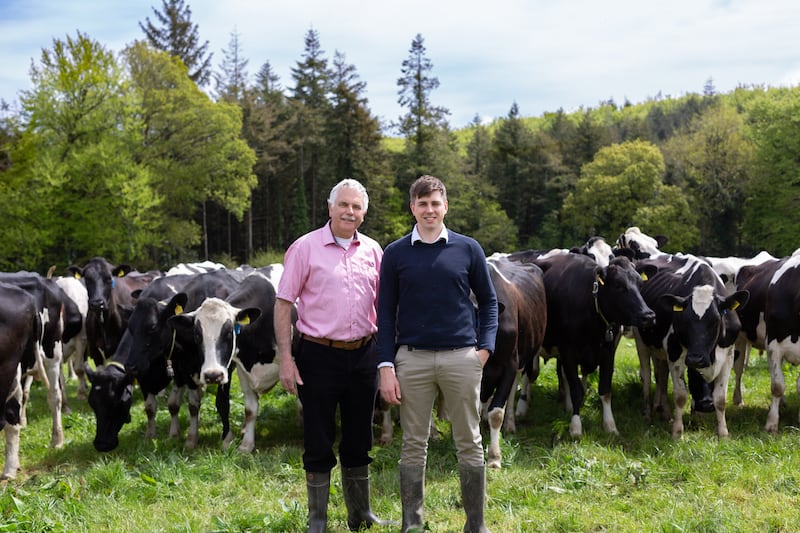Eamonn Lonergan’s light bulb moment came watching a documentary on RTÉ. It was the mid-1980s and he had taken over running his family’s dairy farm in the townland of Ballyneety, in west Waterford’s Knockanore parish.
The show featured Veronica Steele from west Cork’s pioneering Milleens Cheese. The first thing that struck Lonergan was the process, which reminded him of his childhood visiting an uncle who worked at a dairy.
“Even as a boy I was fascinated by that time when milk becomes curds and whey,” he says. “It’s like magic.”
The second thing was that the Steeles were doing this with milk that came from cows on poor, stony soil, nothing like the rich grass that grows in the Blackwater Valley.
“It seemed to me we had better land this side of the country and much better milk,” says Lonergan.
So off he went to University College Cork, Ireland’s incubator of fine cheeses, and in 1987 he started making cheese seriously as part of the first wave of modern Irish artisanal cheesemaking pioneers. Milleens had started in the mid-1970s, followed by Cashel Blue in 1984 and Cooleeney Farm in 1986.
Raw milk was an object of fear then. They wanted everyone to go pasteurised. But to me, it was a point of difference for us. It’s the flavour of the land
Nearly 40 years later, Knockanore Farmhouse cheddar, made only with milk from the farm’s herd of Friesian cows and only during the warmer months when they are feeding on grass from the roughly 200-acre farm, is regarded as one of Ireland’s standout cheeses.
Knockanore Farm cheddars are vacuum-packed for ageing, so stylistically they are somewhere between industrial cheeses and the more austere, granular traditional farmhouse cheddars.
Tasted side by side with a mass-market cheddar, the difference is unmistakable. The flavour is multilayered and complex rather than the simple one-note with which we’re so familiar.
Making a great cheese like this is a challenge in itself, but as if that wasn’t enough, Lonergan set himself two further hurdles.
First, he chose to stake his claim on cheddar – competing directly against the big industrial dairies. “There were a few people at the time doing cheddar, but they weren’t doing it at any great level,” he says. “So I thought maybe here’s a chance. Plus, it let me make more volume and have increased shelf life.”
[ Gourmet getaways: The best places to eat and drink in ConnemaraOpens in new window ]

Furthermore, he chose to make that cheese from raw milk rather than pasteurised, one of the first of its kind in Ireland and even today one of only a dozen or so raw milk cheeses of any kind made here. At that time it flew in the face of warnings from food professionals, but Lonergan knew the long ageing of cheddar would make it safe.
“There was a bit of fighting against it,” he says. “Raw milk was an object of fear then. They wanted everyone to go pasteurised. But to me, it was a point of difference for us. It’s the flavour of the land. Using raw milk gives the flavours of the environment, gives the flavour of the countryside, of where the cows are grazing. Why would you kill something that gives some of the flavour?”
Having established Knockanore cheddar as a prize cheese, Lonergan didn’t rest on his laurels. In 1992 he decided to introduce a smoked cheese. At first he used an old freezer in the dairy yard and smoked wheels of cheddar over oak scraps.
This smoked cheddar became so popular it soon became Knockanore’s flagship product. Today the cheese is smoked in a room-sized chamber that can handle up to 300 wheels at a time. But it is still smoked over real wood chips – no artificial flavouring added. Today, of the roughly 15,000-20,000 wheels of Knockanore cheddar made every year, about 65 per cent ends up being smoked.
[ Restaurants offering seriously good food and great value for summer get-togethersOpens in new window ]
The innovation continues to this day. While selling a prize-winning cheese like Knockanore has its rewards, financially it can be a struggle. Growth is limited to the size of the dairy herd your land can support, which is governed by EU regulations.
With that in mind, in 2019 Lonergan started a brand of flavoured cheddars called Bride Valley, made with pasteurised cheeses from other farms, which are then ground, flavoured with anything from sun-dried tomatoes to horseradish, and re-pressed into wheels. This now accounts for an additional 7,000-10,000 wheels of cheese.
If you’re just doing a raw milk cheese, that’s a premium product, and not everyone loves that
He also makes own-brand cheeses for several grocery chains and even custom-cuts and packs cheeses for other cheesemakers from all over Europe.
This multifaceted approach really paid off when Lonergan’s 31-year-old son, Edward, decided to return to the farm after his training as a chartered accountant. He had been working for Musgrave’s, parent company of SuperValu and Centra, picking up valuable retail experience.
“The challenge then was to get the business to a point where it could support two families,” says Lonergan.
With Eamonn, who is now 67, ready to slow down a bit, this diversification is key to ensuring that Knockanore Farm thrives into the next generation, says Edward.
“It’s incredibly hard to grow a farm, even with the best will in the world, mainly because you need the land to do it and land is scarce,” he says. “If you’re just doing a raw milk cheese, that’s a premium product, and not everyone loves that. This is a way of diversifying by making a quality pasteurised cheddar at a lower price point and getting into more customers’ baskets.
“Cheddar is the largest cheese produced around the world, but artisan cheese farmers are such a small part of that. This is our way of trying to increase our market share and not be fully reliant on the artisan product.”

















